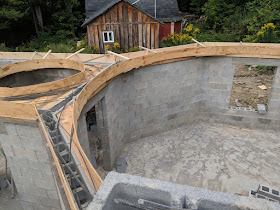This material is based
upon work supported by the National Science Foundation under Grant
No. 1660075 ("Topological interlocking manufactured concrete
block"). Any opinions, findings, and conclusions or recommendations
expressed in this material are those of the author, and do not necessarily
reflect the views of the National Science Foundation.
My company was awarded a
Phase II funded project by the National Science Foundation. The main objective of this work was to
demonstrate our innovative masonry systems, and to obtain a positive evaluation
report from the International Code Council- Evaluation Services. In order to
achieve this, it was strongly suggested by ICC-ES that we work with a Registered
Design Professional architect and a licensed Professional Engineer to design
and build a test or sample building for the purposes of evaluation.
We began with the building
design, in consultation with Robert Ferry, RDP, AIA and Cheng-Ning Jong, PE. The
basic approach was to keep the entire structure under compression, being squeezed
together, which is how masonry is strongest.
We incorporated several different types of arches, domes and half-domes,
configured with flying buttresses.
Work began with excavation
for the footer. This work was done room
by room, in sequence, simply so we had a place to put all the excavated dirt
while we worked.
The footer had its
reinforcement rebar detailed by the PE. All footer sections used formwork to
establish dimensions. Rebar laid flat, horizontally, was tied to the vertical
rebar which would go up into the walls.
This was done using ninety-degree elbows of rebar. All rebar was “Gatorbar”
basalt-based Fiber Reinforced Polymer rebar, which is lightweight, stronger
than steel in tension, and never rusts.
This rebar also bends easily to provide curves for arched roofs.
Once the footer was poured,
stem walls were built to make the foundation come up to grade, where the
vertical walls began, above grade.
After the stem walls were
built, the floor was filled back in with the excavated earth and compacted to a
solid mass.
My next blog entry will
talk about the next steps in construction.






























